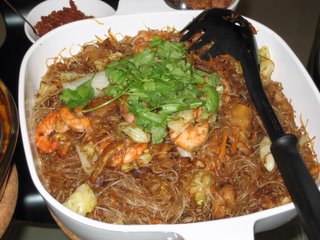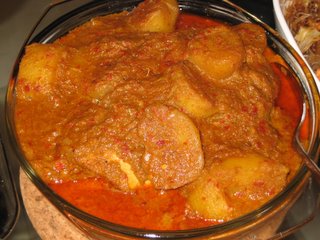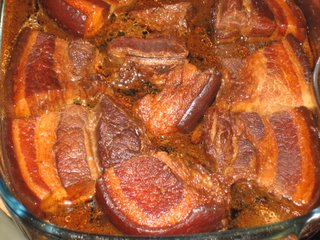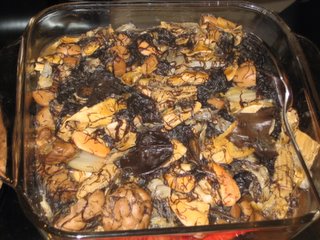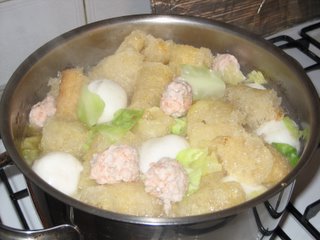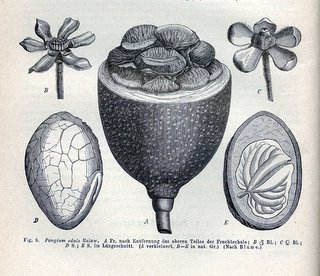US Beef is back!

One of the main grouses about our modern day urbanized kids is that the bulk of them have never had close contact with chickens (not a bad thing, looking at the spread of bird flu) and I remember that Ben had this mental hurdle trying to connect the neat little cling-wrapped packages of beef with a real live cow.
A conversation with my brother also revealed that most people don't even know what cut of beef should be used for grilling, frying, roasting, stewing and braising. This blog entry is to educate people like him whose main encounter with beef is via BBQ sausages (sigh). Also, I am celebrating the return of US beef, the flavour of which we have missed for the past 2 years. I have some qualms about the safety of the beef still, as I am not too sure if they still butcher "downers" (cattle that fall down are butchered immediately; they don't specifically test them for any signs of BSE). But given the global worries about poultry, I figure that beef is a reasonable alternative (cost benefit ratio!).

Anyway, the quality of beef is dependent on the maturity, marbling, firmness, colour and texture. Beef from young cattle is labelled "prime" (best), "choice", "select" or "standard" based on these qualities. Older cattle >42 months old are usually canned or used for other nefarious purposes. Then there is dry and wet aging - methods where beef is allowed to age 10 - 14 days to improve on the tenderness and flavour of the cut.
The 4 major primal cuts are chuck, rib, loin and round, and the "thin" meats are foreshank, brisket, short plate and flank. Rib roasts can be taken from the chuck to the loin end, depending on the kind of roast you want to make. The loin is where one gets porterhouse and T-bone steaks (bone in) and sirloin, tenderloin and other lovely cuts like fillet mignon and chateaubriand. Beef chuck can be used for steaks as well as for stews. Beef round is good for roasts, minute steaks and even sandwiches. The "thin" meats are good for fajitas, fillets and Philadelphia steaks. Leftover bits usually go into ground beef, diced beef and chunks for stewing.
An aside - since it was reported in the NY times today - meat sellers in the US are treating the meat with carbon monoxide so that it will retain the rosy red colour of freshly cut meat. So people buying may end up with a product that is no longer fresh, but you wouldn't know unless you smelt it. Apparently solid cuts that are treated can be sold up to 35 days after leaving the plant. Eww to that...
Anyway, finished with the burbling. Here is my recipe for standing rib roast. My mother had a friend who hand carried the meat back from the US and generously shared half of it with us. The meat turned out moist and flavourful, because of the Dijon mustard marinade, and the gravy is to die for...
Standing rib roast (4 rib recipe)
Ingredients
4 rib roast, chined and fat trimmed
1 cup of Dijon mustard
2 tbsp finely chopped thyme
2 tbsp finely chopped rosemary
1 tsp Sea salt
1 tsp coarsely ground black pepper
Method
1. Sprinkle sea salt and black pepper over the whole roast and rub in.
2. Mix thyme and rosemary with the mustard, and coat whole of the roast. Leave overnight in fridge.
3. Preheat oven to 225 deg C, roast meat rib side down in a roasting pan for 15 minutes, then bring temperature down to 160 deg C. Continue roasting for approximately 1 1/2 - 2 hours. Check temperature of roast with meat thermometer - the roast should be about 55 - 60 deg C for medium rare center.
4. Remove roast from oven, cover with foil and allow to stand for 1/2 hour before serving.
Standing rib roast gravy
Ingredients
2 beef stock cubes
1 cup of red wine (Bordeaux)
3 L water
1 cup coarsely chopped carrots
1 cup coarsely chopped celery
2 cups coarsely chopped onions
4 sprigs of thyme
4 sprigs of parsley
1/4 tsp peppercorns
1 tbsp butter
3 tbsp butter
3 tbsp flour
Method
1. Saute the carrots, celery and onions in 1 tbsp butter for about 10 - 15 minutes until the vegetables look brown and caramelized.
2. Add red wine, then beef stock cubes, thyme, parsley, peppercorns and water. Bring to boil, then turn down heat and simmer for 2 hours until the amount of fluid is reduced to about 3 - 4 cups.
3. Strain stock and refridgerate for several hours. Skim off fat when taking out of fridge.
4. When roast is done, pour away drippings from pan, then place pan on stove over 2 burners.
5. Add butter to pan, and when melted, add flour, whisking carefully to ensure that gravy is smooth for about 5 minutes.
6. Add beef stock. Whisk continuously for about 10 minutes.
6. Add salt and pepper to taste. Strain gravy and serve immediately with roast.

